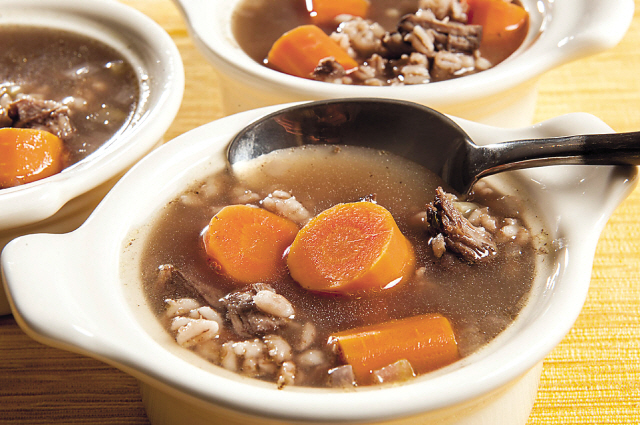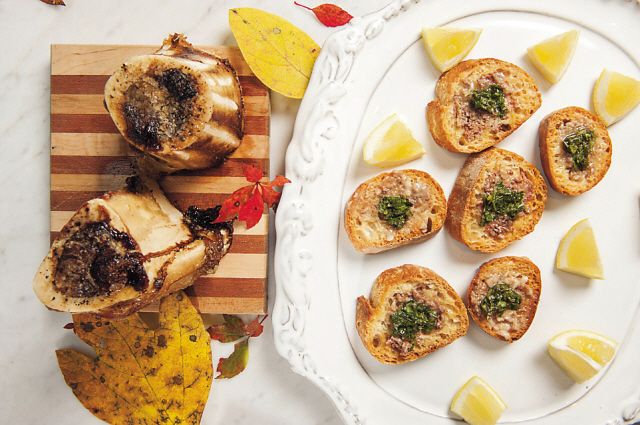Neighborhood children may think of trick-or-treat candy and crunchy leaves in the fall. But for neighborhood cooks, osso buco comes to mind. This is a great time of year to cook with bones. Rich, meaty dishes such as braised short ribs and oxtail soup warm up the kitchen on the chilly nights of November and December.
Bones are scary if you’ve never cooked with them, but once you’ve done it, you’ll see that there is nothing to be afraid of after all.
1. Read your recipe carefully and note how the bones need to be cut. Then, head to the butcher. Most oxtail soup recipes call for lengths of 2 to 3 inches. Sometimes, short ribs are cut into shorter or longer lengths. Unless you have a bone saw in a kitchen drawer, you will want your butcher to do the cutting. Ideally, all pieces should be about the same size, so they cook at the same rate. Bones freeze well, so if you only visit the butcher occasionally you might want to pick up some short ribs along with your veal shanks and freeze them for a cold and rainy day.
2. Do take a few minutes before fixing and forgetting your short ribs, osso buco or oxtail soup to brown the meat. The caramelization that occurs during this extra step will add yet another layer of flavor to your dish.
3. When cooking bones, low and slow in a moist environment is the rule. The collagen that holds together the muscle fibers in the meat surrounding bones is extremely tough. Miraculously, when it is cooked to a temperature of 160 degrees it begins to dissolve, rendering the meat tender. But the only way to get the internal temperature of your meat to 160 without drying it out is to simmer gently in liquid. Eventually, the meat will get hot enough to fall apart, but will also stay moist as it bathes in the sauce as well as its own melted collagen and fat.
To test for doneness, gently insert a sharp paring knife into the meat at a few points. If it slides in very easily, it is done. If the meat is still tough in parts, let it cook another 30 minutes and check again.
4. If you’d like to store your cooked bones overnight before serving, separate the meat and sauce into two containers. Skim the solidified fat from the sauce an hour before you want to eat, transfer the meat on the bone to a baking dish and top with the sauce, cover with heavy duty foil, and reheat at 325 degrees until the meat is warmed through and the sauce is gently bubbling, about 45 minutes.
(MCT Information Services)
Oxtail and barley soup
● 2 pounds oxtails, cut into 1-inch pieces, rinsed and patted dry
● Salt
● Ground black pepper
● 1 tablespoon olive oil
● 1 onion, finely chopped
● 2 ribs celery, finely chopped
● 2 cloves garlic, finely chopped
● 1 tablespoon tomato paste
● 1 cup red wine
● 10 cups water
● 1 cup pearl barley
● 4 carrots, peeled and cut into 1/2-inch pieces
● 1 bay leaf
● 3 sprigs thyme
1. Sprinkle oxtails with salt and pepper. Heat olive oil over medium-high heat in a large Dutch oven and brown oxtails on all sides, 8 minutes total. Transfer to a plate and discard all but 2 tablespoons fat.
2. Add onion, celery and garlic to pot and cook, stirring occasionally, until vegetables are softened, 2 to 3 minutes. Stir in tomato paste and cook another minute. Add wine to pot, bring to a boil and scrape up any browned bits.
3. Return oxtails to pan along with water, bring to a simmer and skim off any foam that rises to surface. Add barley, carrots, bay leaf and thyme, cover, reduce heat and simmer until meat and barley are tender, about 1 hour. Remove meat from bones and return to soup. Season with salt and pepper. Makes 8 servings.
Beef marrow crostini with gremolata
Roasted beef marrow has been described as “meat butter” and “poor man’s foie gras.” These nicknames will give you an idea of how rich and delicious it is. This recipe is the exception to the slow cooking rule. If you roast marrow bones at a high heat for just 20 minutes, the heat will melt the marrow to a spreadable consistency, perfect for spreading onto toasted slices of baguette.
● 1/2 baguette, cut into 1/2-inch-thick rounds
● 4 tablespoons olive oil, divided
● 2 cloves garlic, peeled, divided
● 4 (3- to 4-inch-long) center-cut beef marrow bones
● Salt
● Ground black pepper
● 1 teaspoon lemon zest
● 2 tablespoons finely chopped fresh parsley
● Lemon wedges for serving
1. Preheat oven to 350 degrees. Place baguette rounds on a baking sheet, lightly brush with 1 tablespoon olive oil, and bake until light golden, about 12 minutes. Rub lightly with 1 clove garlic and set aside.
2. Turn heat to 450 degrees. Line another baking sheet with heavy-duty foil. Place bones on sheet, cut sides up. Drizzle with 2 tablespoons olive oil and sprinkle with salt and pepper. Roast until marrow is softened but not yet running out of bones, about 20 minutes.
3. While bones are roasting, combine lemon zest, parsley, remaining 1 tablespoon olive oil and 1/2 teaspoon salt in a small bowl.
4. Scoop marrow out of bones and spread onto toasts. Sprinkle with parsley mixture and serve immediately with lemon wedges on the side.
Makes 4 appetizer servings.
By Lauren Chattman
(Newsday)
Bones are scary if you’ve never cooked with them, but once you’ve done it, you’ll see that there is nothing to be afraid of after all.
1. Read your recipe carefully and note how the bones need to be cut. Then, head to the butcher. Most oxtail soup recipes call for lengths of 2 to 3 inches. Sometimes, short ribs are cut into shorter or longer lengths. Unless you have a bone saw in a kitchen drawer, you will want your butcher to do the cutting. Ideally, all pieces should be about the same size, so they cook at the same rate. Bones freeze well, so if you only visit the butcher occasionally you might want to pick up some short ribs along with your veal shanks and freeze them for a cold and rainy day.
2. Do take a few minutes before fixing and forgetting your short ribs, osso buco or oxtail soup to brown the meat. The caramelization that occurs during this extra step will add yet another layer of flavor to your dish.
3. When cooking bones, low and slow in a moist environment is the rule. The collagen that holds together the muscle fibers in the meat surrounding bones is extremely tough. Miraculously, when it is cooked to a temperature of 160 degrees it begins to dissolve, rendering the meat tender. But the only way to get the internal temperature of your meat to 160 without drying it out is to simmer gently in liquid. Eventually, the meat will get hot enough to fall apart, but will also stay moist as it bathes in the sauce as well as its own melted collagen and fat.
To test for doneness, gently insert a sharp paring knife into the meat at a few points. If it slides in very easily, it is done. If the meat is still tough in parts, let it cook another 30 minutes and check again.
4. If you’d like to store your cooked bones overnight before serving, separate the meat and sauce into two containers. Skim the solidified fat from the sauce an hour before you want to eat, transfer the meat on the bone to a baking dish and top with the sauce, cover with heavy duty foil, and reheat at 325 degrees until the meat is warmed through and the sauce is gently bubbling, about 45 minutes.
(MCT Information Services)
 |
| Oxtail and barley soup |
Oxtail and barley soup
● 2 pounds oxtails, cut into 1-inch pieces, rinsed and patted dry
● Salt
● Ground black pepper
● 1 tablespoon olive oil
● 1 onion, finely chopped
● 2 ribs celery, finely chopped
● 2 cloves garlic, finely chopped
● 1 tablespoon tomato paste
● 1 cup red wine
● 10 cups water
● 1 cup pearl barley
● 4 carrots, peeled and cut into 1/2-inch pieces
● 1 bay leaf
● 3 sprigs thyme
1. Sprinkle oxtails with salt and pepper. Heat olive oil over medium-high heat in a large Dutch oven and brown oxtails on all sides, 8 minutes total. Transfer to a plate and discard all but 2 tablespoons fat.
2. Add onion, celery and garlic to pot and cook, stirring occasionally, until vegetables are softened, 2 to 3 minutes. Stir in tomato paste and cook another minute. Add wine to pot, bring to a boil and scrape up any browned bits.
3. Return oxtails to pan along with water, bring to a simmer and skim off any foam that rises to surface. Add barley, carrots, bay leaf and thyme, cover, reduce heat and simmer until meat and barley are tender, about 1 hour. Remove meat from bones and return to soup. Season with salt and pepper. Makes 8 servings.
 |
| Beef marrow crostini is made with with gremolata. (Newsday/MCT) |
Beef marrow crostini with gremolata
Roasted beef marrow has been described as “meat butter” and “poor man’s foie gras.” These nicknames will give you an idea of how rich and delicious it is. This recipe is the exception to the slow cooking rule. If you roast marrow bones at a high heat for just 20 minutes, the heat will melt the marrow to a spreadable consistency, perfect for spreading onto toasted slices of baguette.
● 1/2 baguette, cut into 1/2-inch-thick rounds
● 4 tablespoons olive oil, divided
● 2 cloves garlic, peeled, divided
● 4 (3- to 4-inch-long) center-cut beef marrow bones
● Salt
● Ground black pepper
● 1 teaspoon lemon zest
● 2 tablespoons finely chopped fresh parsley
● Lemon wedges for serving
1. Preheat oven to 350 degrees. Place baguette rounds on a baking sheet, lightly brush with 1 tablespoon olive oil, and bake until light golden, about 12 minutes. Rub lightly with 1 clove garlic and set aside.
2. Turn heat to 450 degrees. Line another baking sheet with heavy-duty foil. Place bones on sheet, cut sides up. Drizzle with 2 tablespoons olive oil and sprinkle with salt and pepper. Roast until marrow is softened but not yet running out of bones, about 20 minutes.
3. While bones are roasting, combine lemon zest, parsley, remaining 1 tablespoon olive oil and 1/2 teaspoon salt in a small bowl.
4. Scoop marrow out of bones and spread onto toasts. Sprinkle with parsley mixture and serve immediately with lemon wedges on the side.
Makes 4 appetizer servings.
By Lauren Chattman
(Newsday)




No comments:
Post a Comment